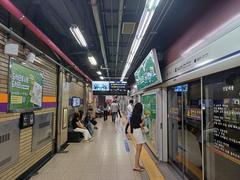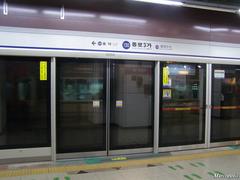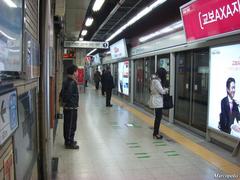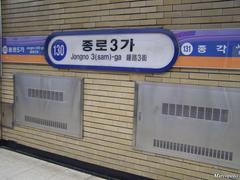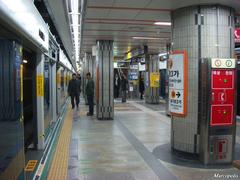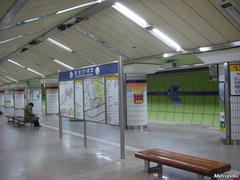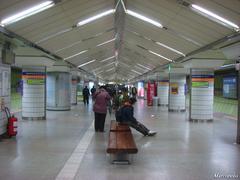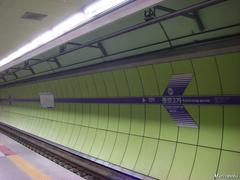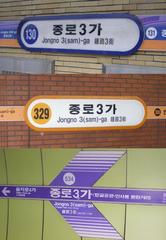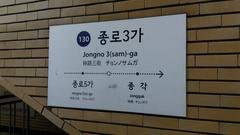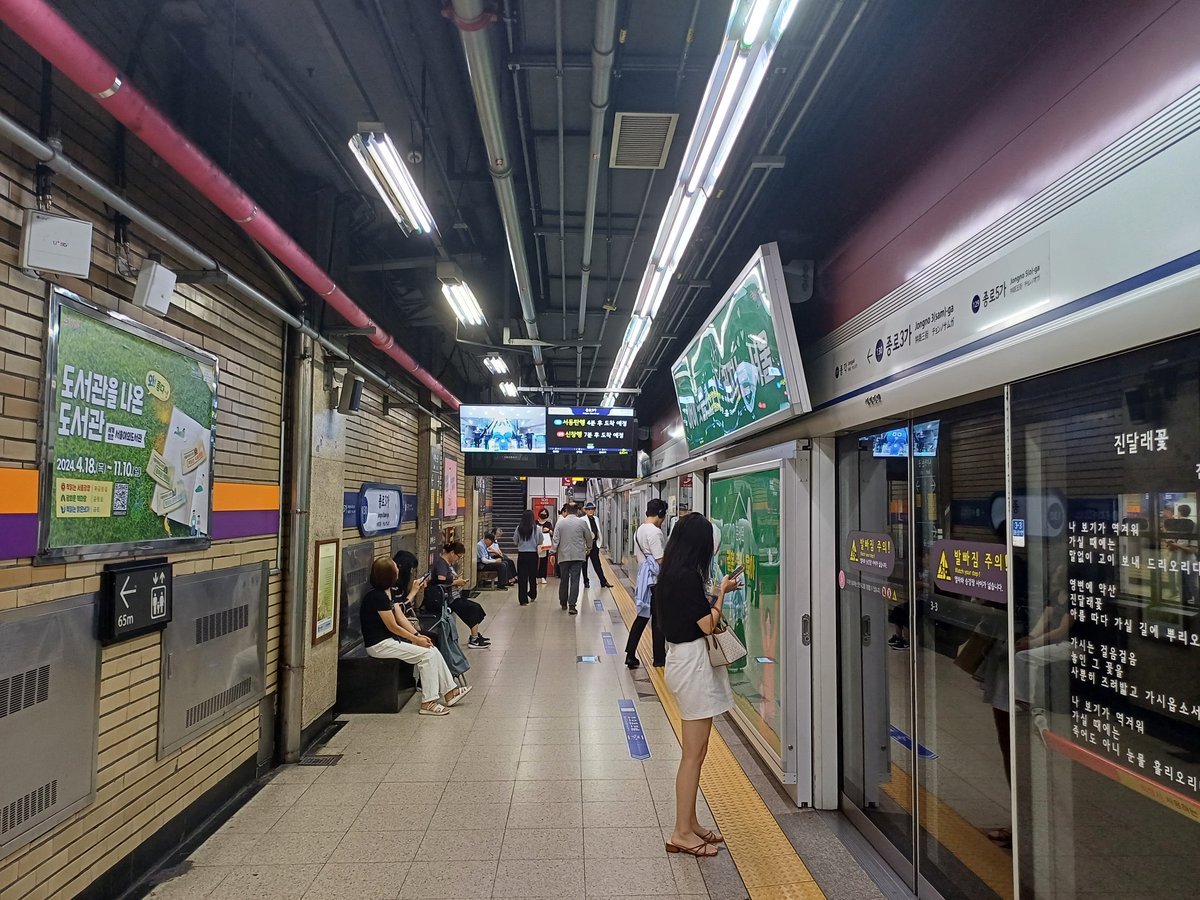
Jongno 3-Ga Station Seoul: Visiting Hours, Tickets, and Tourist Guide
Date: 14/06/2025
Introduction
Jongno 3-ga Station (종로3가역) is a major interchange on Seoul Subway Lines 1, 3, and 5, serving as a vital entry point to the city’s historic core. Located in Jongno-gu, this station is more than just a transit hub—it’s a gateway to centuries of Korean heritage, vibrant markets, and some of Seoul’s most celebrated neighborhoods. With convenient access to UNESCO World Heritage sites, traditional hanok villages, lively street food alleys, and diverse nightlife, Jongno 3-ga offers travelers a rich tapestry of experiences blending old and new.
This comprehensive guide provides up-to-date information on visiting hours, ticketing, accessibility, and travel tips for Jongno 3-ga Station and its surrounding attractions. Whether you’re a history buff, culture enthusiast, foodie, or casual tourist, you’ll find essential insights to help you make the most of your visit. For additional resources, refer to Seoul Metro, Korea Cultural Heritage Foundation, and The Korea Herald.
Origins and Development of Jongno 3-ga Station
Jongno 3-ga Station opened on August 15, 1974, as part of the inaugural Seoul Subway Line 1, marking the dawn of modern rapid transit in South Korea (Wikipedia). The station later expanded to include Line 3 in 1985 and Line 5 in 1996, becoming one of Seoul’s few triple-line transfer points (Seoul Sub→urban). Its strategic development reflects Jongno’s enduring significance as Seoul’s historical and administrative center.
Visiting Hours and Ticket Information
- Subway Hours: Approximately 5:30 AM–midnight daily.
- Ticketing: Entry to the station is free. To travel, purchase tickets at vending machines or use transportation cards like T-money, available at convenience stores and station kiosks (Seoul Metro).
- Attraction Hours: Many nearby sites such as Jongmyo Shrine and Tapgol Park are typically open from 9:00 AM–6:00 PM (may vary by season). Entry fees range from free to a nominal charge. Always check official websites for current details.
Accessibility and Travel Tips
Jongno 3-ga Station is designed for inclusivity, featuring elevators, ramps, tactile paving, and clearly marked signage in Korean and English. With 16 exits, the station grants easy access to surrounding attractions. To avoid crowds, plan your visit outside peak hours (7:30–9:30 AM and 5:30–7:30 PM). Download navigation apps like KakaoMap or Naver Map for real-time guidance.
Strategic Urban and Historical Significance
Situated at the heart of Jongno-gu, Jongno 3-ga Station is steps away from Seoul’s most iconic sites:
- Tapgol Park: Exit 1 leads to this historic park, home to the 10-story Wongaksa Pagoda and the birthplace of the 1919 March 1st Independence Movement (The Soul of Seoul).
- Jongmyo Shrine: Exit 11 offers access to this UNESCO World Heritage Site, renowned for royal ancestral rites and Confucian architecture (Seoul Sub→urban).
- Insadong: Accessible from Exit 1, this vibrant street is famed for traditional teahouses, antique shops, and art galleries (Korea Herald).
Jongno 3-ga’s surrounding areas also include Bosingak Belfry, Gwangjang Market, and clusters of hanok villages, making it a central node for exploring Seoul’s living heritage.
Social and Cultural Landscape
The Jongno area blends rich tradition with modern creativity. Ikseon-dong, adjacent to the station, is a trendy hanok neighborhood filled with chic cafes and boutique shops. The area is also home to a well-established LGBTQ+ nightlife scene, offering inclusive bars and clubs (Korea Herald). Meanwhile, local markets and restaurants cater to all ages, reflecting Seoul’s dynamic urban identity.
Economic and Commercial Importance
Jongno 3-ga anchors commercial districts such as the Jongno Jewelry District and Nagwon Arcade—Asia’s largest musical instrument market. Nearby markets, including Gwangjang and Tongin, are celebrated for authentic street food and local crafts (Seoul Korea Asia).
Architectural and Urban Features
The station’s underground design is emblematic of Seoul’s early subway architecture, while above ground, Jongno blends modern landmarks like Jongno Tower with historic hanok residences and temples (Wikipedia; All South Korea). Wide pedestrian avenues and narrow alleys invite exploration on foot.
Exploring Changdeokgung Palace: Visiting Hours, Tickets, and Nearby Historical Sites
Introduction
Changdeokgung Palace is a UNESCO World Heritage Site celebrated for its harmonious integration with the natural landscape. Built in 1405, it served as a principal royal residence through much of the Joseon Dynasty. The palace’s Secret Garden (Huwon) is a highlight, featuring serene pavilions, lotus ponds, and ancient trees.
Visiting Information
- Hours: March–October: 9:00 AM–6:00 PM (last entry 5:00 PM); November–February: 9:00 AM–5:00 PM (last entry 4:00 PM). Closed Mondays.
- Tickets: ₩3,000 for adults, ₩1,500 for youth (7–18), free for children under 6. Secret Garden tour: ₩5,000; advance reservation required (Official Changdeokgung Palace Website).
- Location: 12-minute walk from Jongno 3-ga Station Exit 6.
Guided tours are available in multiple languages, and the palace is largely wheelchair accessible, though some historic areas have limited access.
Nearby Landmarks
- Jongmyo Shrine: 10-minute walk; open 9:00 AM–6:00 PM (closed Tuesdays).
- Ikseon-dong Hanok Village: Traditional houses with modern cafes; accessible from Exit 4.
- Insadong: Art galleries, antique shops, and teahouses; near Exit 5.
- Cheonggyecheon Stream: Urban stream ideal for scenic walks; accessible from Exits 1 and 3.
Historical and Cultural Landmarks Near Jongno 3-ga Station
- Jongmyo Shrine: Korea’s oldest Confucian royal shrine, hosting the UNESCO-listed Jongmyo Jerye ritual (Korea Herald).
- Bosingak Belfry: Iconic bell pavilion where the New Year’s Eve bell-ringing ceremony takes place.
- Tapgol Park: Site of the 1919 independence movement, featuring the famed Wongaksa Pagoda (The Soul of Seoul).
Traditional Neighborhoods and Hanok Villages
- Ikseon-dong: Accessible from Exit 5, this hanok neighborhood is known for its blend of tradition and trendsetting cafes and shops (Creatrip).
- Nakwon-dong and Nagwon Arcade: Multi-story complex of musical instrument shops, surrounded by makgeolli houses and eateries.
- Bukchon Hanok Village: A larger hanok district with art galleries, tea houses, and craft shops (I Wandered).
Culinary Experiences and Nightlife
- Jongno 3-ga Pocha Street: Lined with pojangmacha (tent bars) and street food stalls, offering favorites like bindaetteok, tteokbokki, and odeng (Trendy Korean Culture).
- LGBT-Friendly Bars: Discreet venues in Nakwon-dong and Ikseon-dong create a welcoming nightlife scene (Korea Herald).
- Traditional Makgeolli Restaurants: Classic rice wine houses serving homestyle Korean food.
Art, Shopping, and Modern Attractions
- Insa-dong: Traditional street with tea houses, antique stores, and the Ssamziegil shopping complex (Creatrip).
- Jongno Tower: Modern landmark with panoramic city views.
- Songhae-gil: Street dedicated to TV icon Song Hae.
Festivals, Events, and Local Customs
- New Year’s Eve Bell-Ringing: Annual ceremony at Bosingak Belfry (Korea Herald).
- Jongmyo Jerye Ritual: UNESCO-listed Confucian rite, held annually at Jongmyo Shrine.
Practical Visitor Tips
- Navigation: Use station maps and bilingual signage for exits.
- Tickets: T-money cards offer seamless travel; palace and shrine tickets can be bought online or on-site (Korea Travel Post).
- Best Seasons: Spring and autumn for pleasant weather and festivals.
- Hanbok Discount: Wearing hanbok may grant free or discounted entry to palaces (I Wandered).
- Accessibility: Most sites are accessible, but check individual venues for details.
Unique Local Experiences
- Yajang (Outdoor Dining): Enjoy local street food and drinks in open-air settings (Visit Seoul).
- Street Chess in Tapgol Park: Watch or join games of janggi with local seniors.
- Music Shopping at Nagwon Arcade: Explore Asia’s largest musical instrument market.
FAQs
Q: What are Jongno 3-ga Station’s operating hours?
A: 5:30 AM–midnight.
Q: How do I buy tickets for nearby attractions?
A: Use T-money cards for public transport. Tickets for palaces and shrines can be purchased on-site or online.
Q: Are attractions accessible for people with disabilities?
A: Most are, though some hanok areas have uneven terrain.
Q: Are there guided tours?
A: Yes, many are available in multiple languages.
Accommodation Near Jongno 3-Ga Station
Choose from luxury hotels, boutique hanok guesthouses, and budget hostels:
- Hanok Hotel DAAM Seoul: Traditional experience with modern amenities.
- Amare Hotel Jongno: Spacious and centrally located.
- LOTTE City Hotel Myeongdong: Upscale amenities near Euljiro 3-ga.
- Dormy Inn EXPRESS SEOUL Insadong: Close to Jongmyo Shrine.
- Tong Tong Petit Hotel: Boutique style, personalized service.
Book early during peak seasons. Hanok stays provide unique cultural immersion but may have limited accessibility.
For more options, visit Booking.com’s Jongno 3-Ga Station listings.
Dining Highlights
- Korean BBQ: Try Ikseon-dong Ranch or Jongsam Yuk for premium meats.
- Historic Eats: Imun Seolnongtang (since 1904), Jalppajin Memil for unique flavors.
- Markets: Gwangjang Market for street food, Insadong for traditional sweets.
- International Choices: A growing number of vegetarian, vegan, and international options are available.
Essential Travel Information
- Safety: Well-lit, monitored, and safe for visitors.
- Language: Bilingual signage is common; translation apps help.
- Payment: Credit cards widely accepted; cash best for markets and small eateries.
Navigation and Transport
- Subway: Lines 1, 3, and 5; frequent service.
- Airport Buses: Limousine route 6002 connects Incheon Airport to Jongno 3-ga.
- Navigation Apps: KakaoMap and Naver Map are recommended.
For subway navigation, see Korea Travel Planning’s subway guide.
Conclusion
Jongno 3-ga Station is a vibrant nexus where Seoul’s past and present converge. With accessible transit, rich cultural sites, dynamic markets, and diverse food scenes, it offers an immersive introduction to the soul of Korea’s capital. Plan ahead with T-money cards, download local navigation apps, and secure tickets for historical sites in advance. To enhance your journey, download the Audiala app for real-time updates, insider guides, and interactive maps.
For more on Seoul’s subway system, visit Seoul Metro. For detailed history and event updates, see the Korea Cultural Heritage Foundation and The Korea Herald.
References
- Seoul Sub→urban
- Wikipedia
- Official Changdeokgung Palace Website
- Korea Herald
- Korea Travel Post
- Korea Cultural Heritage Foundation
- The Soul of Seoul
- Creatrip
- Seoul Korea Asia
- All South Korea
- I Wandered
- Trendy Korean Culture
- Shuttle Delivery Blog
- Visit Seoul
- Booking.com’s Jongno 3-Ga Station listings
- Korea Travel Planning’s subway guide
